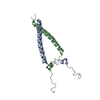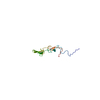登録情報 データベース : PDB / ID : 2m20タイトル EGFR transmembrane - juxtamembrane (TM-JM) segment in bicelles: MD guided NMR refined structure. Epidermal growth factor receptor キーワード / / / 機能・相同性 分子機能 ドメイン・相同性 構成要素
/ / / / / / / / / / / / / / / / / / / / / / / / / / / / / / / / / / / / / / / / / / / / / / / / / / / / / / / / / / / / / / / / / / / / / / / / / / / / / / / / / / / / / / / / / / / / / / / / / / / / / / / / / / / / / / / / / / / / / / / / / / / / / / / / / / / / / / / / / / / / / / / / / 生物種 Homo sapiens (ヒト)手法 / Model details lowest energy, model 1 データ登録者 Endres, N.F. / Das, R. / Smith, A. / Arkhipov, A. / Kovacs, E. / Huang, Y. / Pelton, J.G. / Shan, Y. / Shaw, D.E. / Wemmer, D.E. ...Endres, N.F. / Das, R. / Smith, A. / Arkhipov, A. / Kovacs, E. / Huang, Y. / Pelton, J.G. / Shan, Y. / Shaw, D.E. / Wemmer, D.E. / Groves, J.T. / Kuriyan, J. ジャーナル : Cell(Cambridge,Mass.) / 年 : 2013タイトル : Conformational Coupling across the Plasma Membrane in Activation of the EGF Receptor.
著者 :
Endres, N.F. / Das, R. / Smith, A.W. / Arkhipov, A. / Kovacs, E. / Huang, Y. / Pelton, J.G. / Shan, Y. / Shaw, D.E. / Wemmer, D.E. / Groves, J.T. / Kuriyan, J. #1: ジャーナル : To be Published タイトル : Architecture and Membrane Interactions of the EGF Receptor.
著者 :
Endres, N.F. / Das, R. / Smith, A. / Arkhipov, A. / Kovacs, E. / Huang, Y. / Pelton, J.G. / Shan, Y. / Shaw, D.E. / Wemmer, D.E. / Groves, J.T. / Kuriyan, J. 履歴 登録 2012年12月11日 登録サイト / 処理サイト 改定 1.0 2013年2月20日 Provider / タイプ 改定 1.1 2024年5月1日 Group / Database referencesカテゴリ chem_comp_atom / chem_comp_bond ... chem_comp_atom / chem_comp_bond / database_2 / pdbx_nmr_software / pdbx_nmr_spectrometer / struct_ref_seq_dif Item _database_2.pdbx_DOI / _database_2.pdbx_database_accession ... _database_2.pdbx_DOI / _database_2.pdbx_database_accession / _pdbx_nmr_software.name / _pdbx_nmr_spectrometer.model / _struct_ref_seq_dif.details
すべて表示 表示を減らす
 データを開く
データを開く 基本情報
基本情報 要素
要素 キーワード
キーワード 機能・相同性情報
機能・相同性情報 Homo sapiens (ヒト)
Homo sapiens (ヒト) データ登録者
データ登録者 引用
引用 ジャーナル: Cell(Cambridge,Mass.) / 年: 2013
ジャーナル: Cell(Cambridge,Mass.) / 年: 2013 ジャーナル: To be Published
ジャーナル: To be Published 構造の表示
構造の表示 Molmil
Molmil Jmol/JSmol
Jmol/JSmol ダウンロードとリンク
ダウンロードとリンク ダウンロード
ダウンロード 2m20.cif.gz
2m20.cif.gz PDBx/mmCIF形式
PDBx/mmCIF形式 pdb2m20.ent.gz
pdb2m20.ent.gz PDB形式
PDB形式 2m20.json.gz
2m20.json.gz PDBx/mmJSON形式
PDBx/mmJSON形式 その他のダウンロード
その他のダウンロード https://data.pdbj.org/pub/pdb/validation_reports/m2/2m20
https://data.pdbj.org/pub/pdb/validation_reports/m2/2m20 ftp://data.pdbj.org/pub/pdb/validation_reports/m2/2m20
ftp://data.pdbj.org/pub/pdb/validation_reports/m2/2m20 リンク
リンク 集合体
集合体
 要素
要素 Homo sapiens (ヒト) / 遺伝子: EGFR, ERBB, ERBB1, HER1 / プラスミド: pMMHb / 発現宿主:
Homo sapiens (ヒト) / 遺伝子: EGFR, ERBB, ERBB1, HER1 / プラスミド: pMMHb / 発現宿主: 
 試料調製
試料調製 解析
解析 ムービー
ムービー コントローラー
コントローラー








 PDBj
PDBj












 HSQC
HSQC